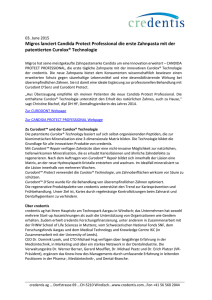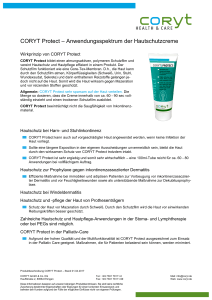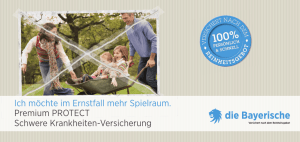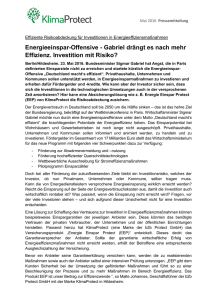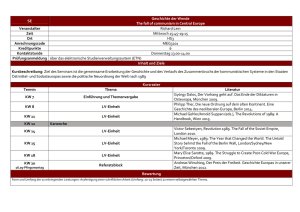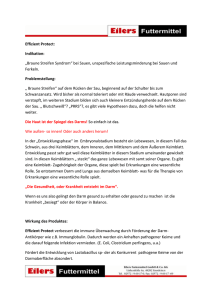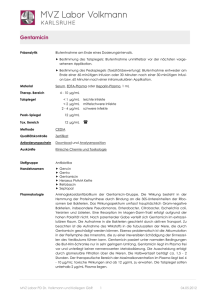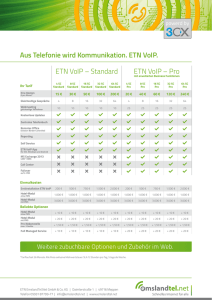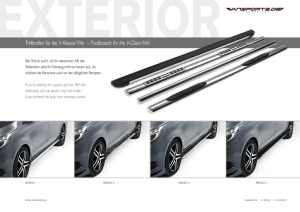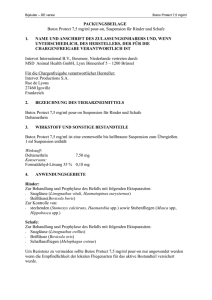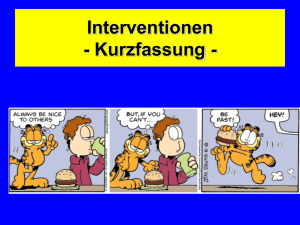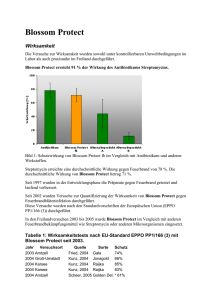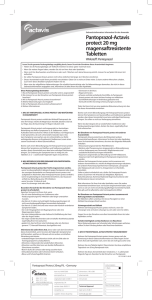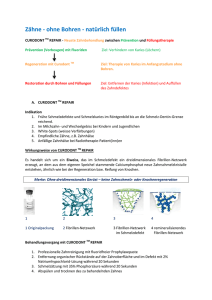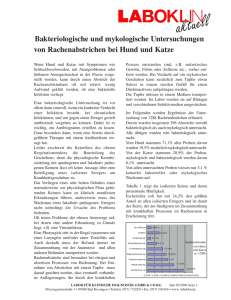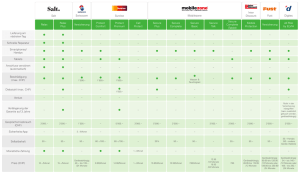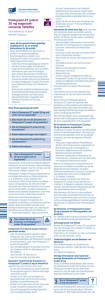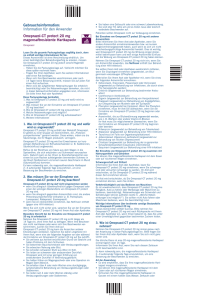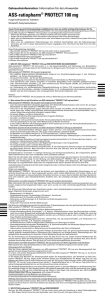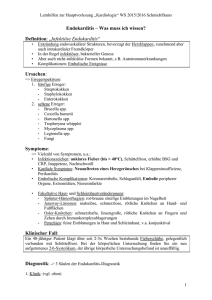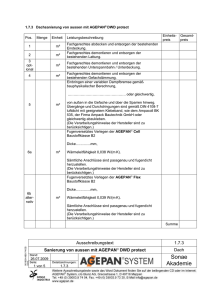Grundlagen der Polytraumaversorgung
Werbung
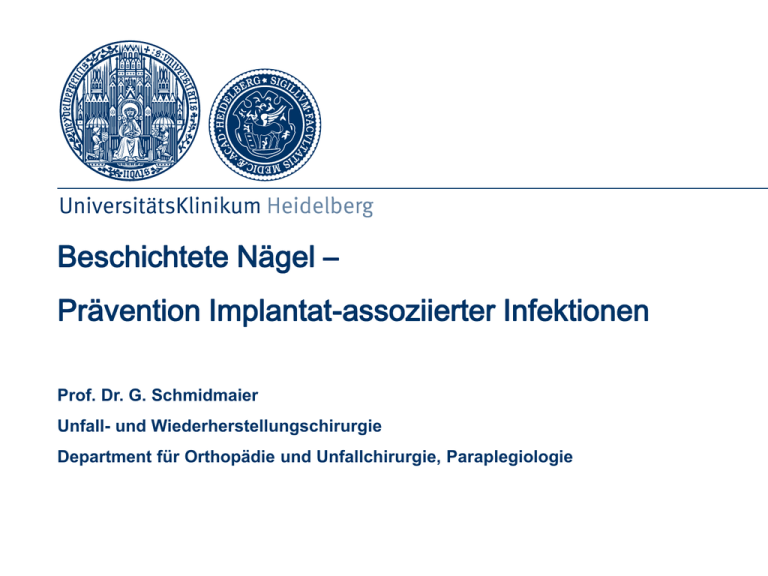
Beschichtete Nägel – Prävention Implantat-assoziierter Infektionen Prof. Dr. G. Schmidmaier Unfall- und Wiederherstellungschirurgie Department für Orthopädie und Unfallchirurgie, Paraplegiologie Problem Komplikationen in 5 – 10 % aller Frakutren • unzureichende Biomechanik • Weichteilschaden • gestörte Biologie Osteoporose Diabetes mellitus Micro-, Macroangiopathie Polyneuropathie Rauchen, Alkohol, Medikamente … Problem Knochenheilungstörung Pseudarthrosen* 2 - 5% Infekte** 3 - 33 % Mechanische Ursachen Hyertrophe Pseudarthrose Biologische Ursachen Atrophe Pseudarthrose Defektgröße Defekt Pseudarthrose + Infektion Infekt Pseudarthrose 3° offene Fraktur Calori G et al., Injury 2008* Papakostidis C et al, Injury 2011** Problem Infekt Implant-assoziierte Infektionen (Sanzen 1995, Biomaterials / Petty 1985, JBJS) • Infektionsrate: - elektive Chirurgie 0.7 – 4.2% (Hanssen 1998 J Bone Joint Surg. Am.) - offene Frakturen 5 - 33% (Ostermann 1994 Orthopedics) • 70 - 90% Staph. aureus & epidermidis • Biofilm (Glycocalix) auf Implantatoberflächen • Unwirksamkeit systemisch applizierter AB (Gristina 1985 Science) Biofilm, Staph. auf Titanoberfläche Zunehmende Sozio-ökonomische Bedeutung ! Schätzungen Kosten pro Fall 1991 1996 2009 61.000 DM 87.000 DM 500.000 Euro Nast-Kolb Chirurg 1991 Mohr Chirurg 1996 Walter Krankenhaushygiene 2009 G. Walter Krankenhaushygiene 2009 Therapie - Prinzipien Chirurgie !!! – RADIKALES DEBRIDEMENT – – – – – – – – – Implantatentfernung Fixateur externe Second look … third look …. Debridement Stabilität WEICHTEILDECKUNG Durchblutung Behandlung Kochendefekt Antibiotika Begleiterkrankungen (Diabetes …) Rauchen einstellen ! Diamond Konzept Mechanische Stabilität Zellen Durchblutung Prävention Wachstumsfaktoren Giannoudis PV, Einhorn TA, Schmidmaier G, Marsh D. The diamond concept--open questions. Injury. 2008:39 Scaffolds Poly(D,L-Lactide) Beschichtung für Implantate IMPLANT = DRUG CARRIER • hohe mechanische Stabilität, Schichtdicke ca.10 µm • Einarbeitung von Wirksubstanzen • kontinuierliche Freisetzung nach initialem Peak • positiver Einfluss auf Heilung Strobel et al. Int J Art Organs 2011 Schmidmaier et al. Bone 2001 Schmidmaier et al. J Biomed Mater Res 2001 Gentamicin Beschichtete Implantate Biodegradierbare Beschichtung Poly(D,L-Lactid) + Gentamicin 10 % (w/w) • Aminoglycoside breites Spektrum • Bacterizider Effekt auf nicht-proliferierende Keime • Etabliert für die lokale Applikation* (PMMA Zement, PMMA-Ketten, Kollagen-Schwämme …) seit über 30 Jahren mit guter Verträglichkeit • Synergistischer Effekt** zu perioperativer systemischer AB Prophylaxe mit Cephalosporinen Prävention Implantat – assoziierte Infektionen Schmidmaier et al. J Biomed Mat Res 2001 Schmidmaier et al. Bone 2001 * Chaudhary S, J Traumatology 2011 ** Hohmann C Infection 2011 Gentamicin Beschichtete Implantate Adhäsion Staph aureus: Freisetzung Gentamycin: 100 Gentamicin Freisetzung in vitro 80 60 % 40 20 0 0sek 20sek 60sek 3min 5min 30min 24h 7d 21d 70 µg / g Bone Fluoreszens Mikroskopie und REM Konzentration Gentamicin Bone 60 42d nach 12 h (Staph. aureus) 50 40 30 20 10 0 1h 6h 12h 24h 2d 4d 7d 1000x Lucke et al. Bone 2003 Schmidmaier et al Injury 2006 unbeschichtet 10% Gentamicin Gentamicin Beschichtete Implantate Infektmodel Ratte 6 Wo Staphylococcus aureus 10² CFU/10 µl Unbesch. Unbesch. PDLLA Gentamicin PDLLA Gentamicin Schmidmaier et al Injury 2006 Lucke et al. Bone 2003 Risiko lokaler Resistenzen ? In vivo 6 Wochen: 10 Sprague Dawley Raten - 103 CFU Staph. aureus IM Insertion PDLLA + Gentamicin beschichtete Implantate MIC - (Vitek, bioMérieux) In vitro: 24 PDLLA + Gentamicin beschichtete Titan Plättchen MIC Staph aureus, Staph epi., E. coli Keine Resistentz auf Gentamicin Transfer in die Klinik UTN / ETN PROtect 34 Jahre w 2° offene Fraktur 4 Wochen 1 Jahr UTN PROtect 41 Jahre w 2° offene Fx 12/2000 Plattenosteosynthese Infekt 11/2004 UTN PROtect 11/2004 11/2005 UTN PROtect 5/2006 8/2006 UTN PROtect 43 Jahre m 3° Fraktur UTN PROtect 1 Woche UTN PROtect 1 Wo 2 Wo UTN PROtect 3 Monate 6 Monate ETN PROtect 18.01.11 ETN PROtect 18.01.11 ETN PROtect 6 Monate ETN PROtect 12 Monate Klinische Studien UTN / ETN PROtect UTN PROtect Multicenter open controlled prospective case series 50 cases* PCI Charité ETN PROtect Multicenter open controlled prospective case series 100 cases** PCI Heidelberg ETN PROtect II Prospective controlled randomized multicenter 350 cases Ongoing PCI Heidelberg 80 % Heilung innerhalb 6 Monate Pseudarthrosen 6,6%* (18-30%) Infektion 2,9%* (8,2-23%) * p < 0.05 *Fuchs et al. Arch Orthop Trauma Surg. 2011 **Schmidmaier et al. Injury 2013 LFN PROtect 42 Jahre m 3° offene Femurfx, Infekt-Pseudarthrose, multiple Revisions-OPs 1999 2005 LFN PROtect 6/2005 11/2005 LFN PROtect RIA (Reaming Irrigation Aspiration) Contra-laterales Femur LFN PROtect 52 Wochen Autologe Spongiosatransplantation “Gold Standard” ? + Osteoinduktiv + Osteokonduktiv + Osteogen Komplikationen: – Minor: 4 - 20,6 % • Hämatom, Serom, • N. cut. femoris lateralis • Schmerzen (15-39% 2 Jahre post Op) – Major: 3,4 - 8,6 % • Fraktur • Blutung • Infektion RIA Reaming Irrigation Aspiration ® RIA Reaming Irrigation Aspiration ® Irrigation port Aspiration port Irrigation & aspiration: 1. Reduction of pressure and heat 2. Clearance of medullary canal 3. Graft harvest FGFa FGFb VEGF PDGFbb IGF-I TGF-ß1 BMP-2 RIA vs Iliac crest + (2.1) (0.5) (0.5) + (2.9) + (1.6) + (3.5) + (3) comparable GF concentration vital osteogenic cells Schmidmaier et al. Bone 2006 Masquelet Technique • PMMA induziert Femdkörperreaktion „Masquelet-Membran“ • nach 6 Wochen Entfernung PMMA und Defektfüllung mit autologer Spongiosa • in Kombination mit RIA und BMPs „Neo –Periosteum“ Vascularisation ETN PROtect + 21 d +6w MASQUELET TECHNIQUE +8w ETN PROtect +4 w +8w + 3 Mo Diamond Konzept 63 Jahre, m Infektpseudarthrose Tibia 103 Monate nach III° offener Tibiafraktur 31 Revisionsoperationen !!! Raucher NSAR Adipositas Segmentresektion Infektsanierung Maquelet-Technik Fixateur externe Diamond Konzept Zellen (RIA) Wachstumsfaktoren (BMP-7) Antibiotika-beschichtetes Implantat (ETN Protect) 106 Monate nach Fraktur 2 Monate nach Revision Diamond Konzept 4 Wochen nach Revision 12 Monate nach Revision Diamond Konzept 15 Monate nach Revision Zusammenfassung Prävention • Chirurgisches Debridement • Frühe Weichteildeckung • Perioperative Antibiotika-Prohylaxe • Lokale Antibiotika Applikation • Antibiotika-beschichtete Implantate Zusammenfassung ETN Protect ETN PROtect Wirksam zur Prophylaxe Implantat-assoziierter Infektionen Prävetion von Re-Infekten bei Revisionen Behandlung von Infektionen ? bei offenen Frakturen und geschlossenen Frakturen mit Risikofaktoren auch in Kombination mit RIA, BMPs, Distraktionsosteogenese Management Infekt-Pseudarthrosen • 257 Patienten mit 260 atrophen Infekt-Pseudarthrosen* 151 m / 106 w; Alter: Median 43 Jahre (21-76) • Vor-Operationen Median 4.1 (0-26) • Follow up > 2 Jahre • 88 % Konsolidierung (≈ 40 % autologe Spongiosa**) - 76 % innerhalb 6 Monate • kein Unterscheid bei Osteoporose / Alter > 65 • keine systemischen Wirkungen BMP Ausblick: FAR Studie Prospective controlled randomized multicenter 750 cases PCI Heidelberg Start 10 2013 * Schmidmaier et al Injury 2013 ** Giannoudis et al Injury 2007 Zusammenfassung Diamond-Konzept mit Kombination aus • Stabiler Osteosynthese • Wachstumsfaktoren • Trägermaterial (TCP) • Zellen (MSCs) • Bioaktive Implantate (ETN PROtect) Verbessern das Outcome der gestörten Frakturheilung insbesondere bei Infektpseudarthrosen Ausblick: Wachstumsfaktoren – beschichtete Implantate Vielen Dank www.klinikum.uni-heidelberg.de/Heidelberg-Trauma-Research-Group
